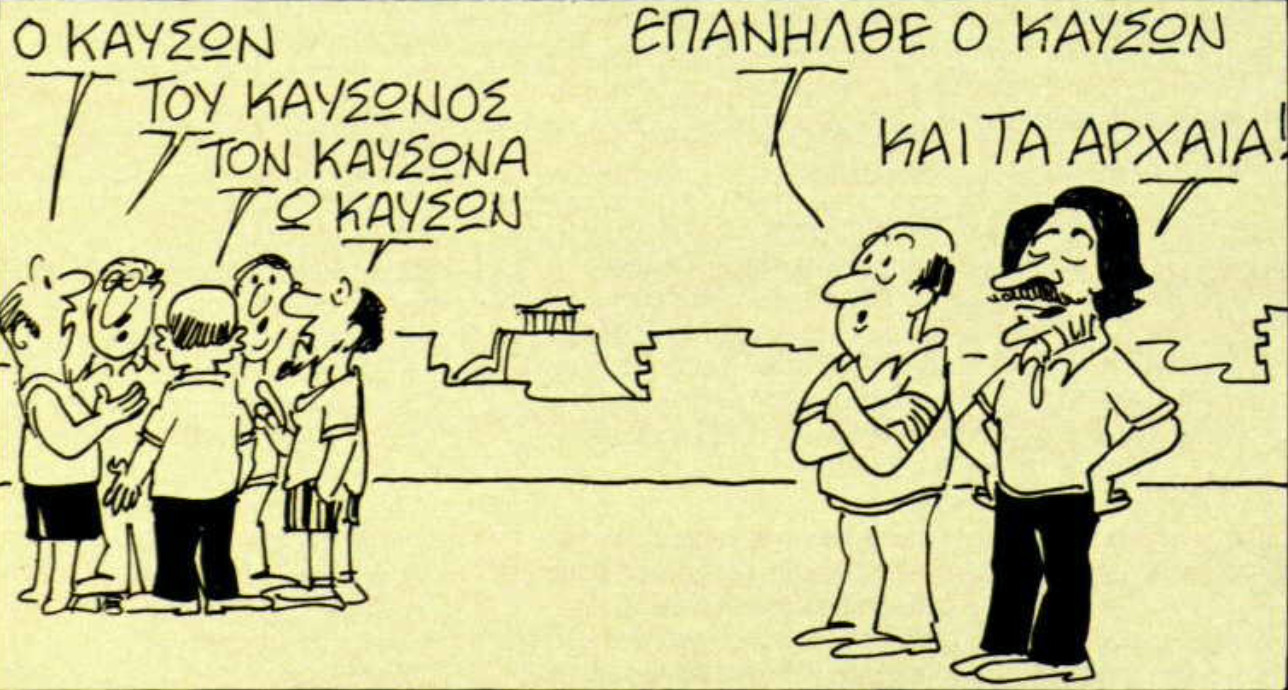Residents of Greece “welcomed” the first heat wave this summer, and, unfortunately, it is unlikely to be the last.
It is now clear that the extreme weather conditions we have experienced in recent years are not just exceptions, isolated events, but the result of a human-caused climate crisis.
Of course, if anyone still has doubts, all they need to do is listen to the words of one of the most competent people, Christos Zerefos, Emeritus Professor of Atmospheric Physics at the University of Thessaloniki and Head of the Department of Meteorology-Climatology at the Academy of Athens.
And since Heat waves (καύσωνες) in Greece have always been a major news topicin connection with the current one, we will try to see the reaction caused by this phenomenon in our country in previous decades.
1. “ΕΛΕΥΘΕΡΟΝ ΒΗΜΑ”, 13.7.1934, Ιστορικό Αρχείο (newspaper archive)
“We have now entered the period of “dog days” (vacations, in Italian). The temperature is quite high (…). The heat affects traffic on the Athenian streets, which are completely deserted at midday, in contrast to the coasts, where there is incredible activity.
The expression “κυνικών καυμάτων” refers to “dog days” or “dog days”, which are the hottest days of summer. This term is associated with the rising of the star Sirius, which is also known as “Alpha Canis Majoris” and is one of the brightest stars in the sky. In ancient times it was believed that the rising of Sirius along with the Sun leads to warmer days, heat.
“The whole coast of Faliro to Vouliagmeni was full of people of all social classes who had camped in the countryside to escape the hellish heat.
“Kavsonas is not an Athenian fruit. The heat spread to all provincial cities. Thus, yesterday morning the temperature fluctuated depending on the city as follows: Corfu +24°C, Thessaloniki, Alexandroupolis +25°C, Florina, Volos, Patras, Chios +26°C, Heraklion, Chania, Lemnos, Larissa, Athens +27 °C, Lamia +28. At noon in Athens the temperature rose to +35.2°C. During the day it exceeded +37°С.
Note: in 1934, heat was considered to be a temperature of +24-35°C, which by today’s standards is “pure nonsense”!

2. “ΕΛΕΥΘΕΡΟΝ ΒΗΜΑ”, 13.7.1943, Ιστορικό Αρχείο (newspaper archive)
In the summer of 1943, the heat in German-occupied Athens gave some people the opportunity to make a fortune. “The obscene speculation on ice continues. It is also strange that the price at which ice cream shops offer ice follows the fluctuations of the thermometer. The higher the mercury rises and the heat increases, the more the price of ice rises.”
3. “ΤΟ ΒΗΜΑ”, 1.7.1956, Ιστορικό Αρχείο “ΤΟ ΒΗΜΑ”/“ΤΑ ΝΕΑ”. Historical archive.
“Since yesterday morning, unprecedented heat has swept across the country, breaking all previous temperature records not only for this year, but also for many previous years.”
“In Athens yesterday the temperature was +41°C in the shade, +46°C in the sun, while in other cities the thermometer showed even higher temperatures.”
“Long queues formed at all beach bus departure points yesterday, both in the morning, midday and afternoon, while hundreds of private cars and trucks were heading out of Athens with tourists.”
“Consumption of soft drinks, ice cream and ice was twice as high as on all other days.”
4. “ΤΟ ΒΗΜΑ”, 1.7.1958, Ιστορικό Αρχείο “ΤΟ ΒΗΜΑ”/“ΤΑ ΝΕΑ”. Historical archive
“The unbearable and suffocating heat lasted 48 hours throughout the country. In the capital, for the first time this year, temperatures above +44°C were recorded in the shade. In some cities, temperatures exceeded +47°C.
“Sunstroke, fainting and small fires were reported in Athens, and the exodus of people on the coast yesterday reached unprecedented proportions, leading to an increase in accidents.”
5. “ΤΟ ΒΗΜΑ”, 1.9.1977, Ιστορικό Αρχείο “ΤΟ ΒΗΜΑ”/“ΤΑ ΝΕΑ”. Historical archive

6. “ΤΑΧΥΔΡΟΜΟΣ”, 10.7.1987, Ιστορικό Αρχείο “ΤΟ ΒΗΜΑ”/“ΤΑ ΝΕΑ”. Historical archive
The heat wave of July 1987 surpassed all others in severity and casualties. Two years later, Georgios Lakopoulos wrote in the BHMA newspaper: “Terror over the city: in the summer of 1987, about 1,300 people died in their homes due to temperatures exceeding 40 degrees.
“We will never forget this July. In Athens, the morgues were full of corpses (…). Elderly people have died from heat stroke.”
“In July of this year the air temperature was extremely high, but Athens turned out to be not such an unfortified city. What's happened? It’s just that most city residents use fans. Others who could afford it installed air conditioners“

7. “ΤΑ ΝΕΑ”, 8.7.1988, Ιστορικό Αρχείο “ΤΟ ΒΗΜΑ”/“ΤΑ ΝΕΑ”. Historical archive
“The cool gates of the Piraeus Peace and Friendship Stadium (Σταδίου Ειρήνης και Φιλίας) and the exhibition center of the Piraeus Port Organization opened to accommodate the “unfortunate” residents of the capital, who were roasting for two days at a temperature of 43 degrees.”
“One of the first to arrive was 35-year-old Claire Skordis from Kalamaki, who brought with her her 80-year-old grandmother and her daughter.”
“Finally ministers began to think that they were not the only ones who could have air conditioning in their offices. Congratulations to whoever came up with this idea.”
“I would like this to happen last year, then there wouldn’t be so many victims,” the journalist added.







More Stories
June this year in Greece was the warmest since 1960
More than 15,000 lightning strikes sparked 62 wildfires on Thursday
Heat: from Monday, July 8th again +40°C